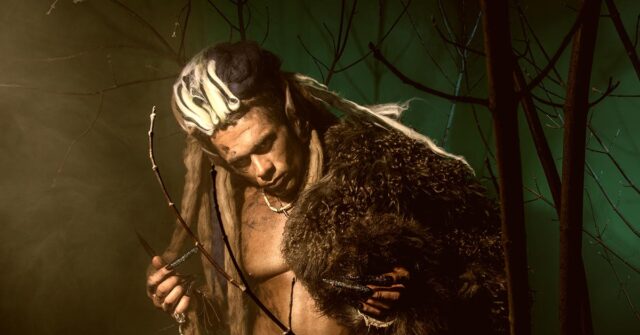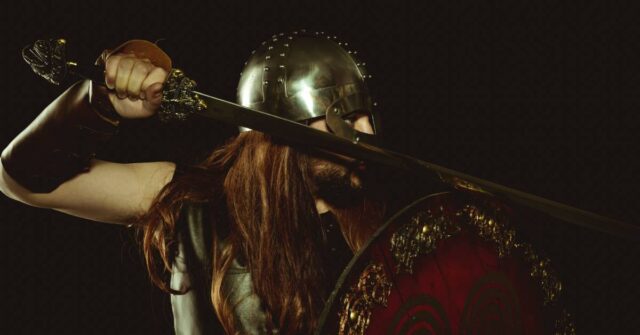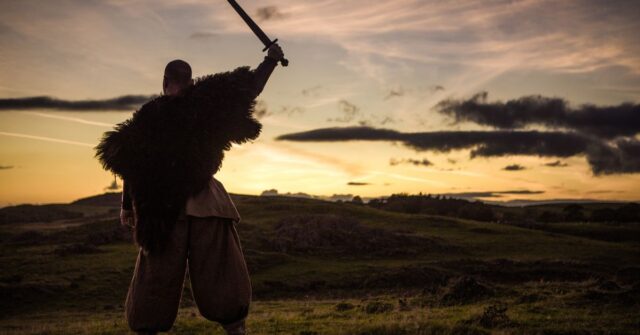In this article, we will explore the fascinating world of the Viking axe, delving into the various types, materials, and fighting techniques associated with these ancient weapons.
We will also examine their historical context and significance within Viking culture, as well as their role in warfare and society.
Introduction to the Viking Axe
The Viking axe is one of the most iconic weapons of the Viking Age, a period spanning from the late 8th to early 11th century.
These versatile tools and weapons were essential to the Norse people, serving various purposes in both daily life and combat situations. They were used not only for warfare but also for farming, woodworking, and shipbuilding.
Historical Context
The Vikings were a seafaring people from the late eighth to early 11th century, originating from the Scandinavian countries of Norway, Denmark, and Sweden.
They were renowned for their daring raids, skilled craftsmanship, and intricate artistry. Their axes, like many other aspects of their culture, reflected the practicality and ingenuity of these fierce warriors and explorers.
Significance of the Axe in Viking Culture
Axes were of great importance in Viking culture, both as practical tools and as symbols of status and power. They represented the strength and prowess of their bearers, and their ornate designs often served as an indication of wealth and social standing.
Axes were also deeply ingrained in Norse mythology, with the gods themselves wielding formidable axes in their legendary exploits.
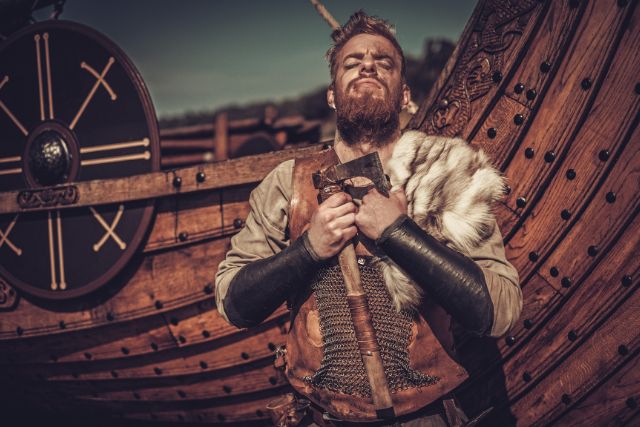
Types of Viking Axes
There were several types of axes used by the Vikings, each with its own unique design and purpose. In this section, we will examine some of the most common and notable types of Viking axes.
Bearded Axe
The bearded axe, also known as the skeggöx, was characterized by a long, curved blade that extended below the handle, resembling a beard.
This design allowed for a larger cutting edge without significantly increasing the weight of the weapon, making it a popular choice for both combat and woodworking tasks.
Broad Axe
Broad axes, also known as hewing axes, featured wide, heavy blades designed for chopping and splitting wood. While not specifically designed for combat, their weight and cutting power made them formidable weapons in the hands of skilled warriors.
Carving Axe
Carving axes were smaller, lightweight axes used for intricate woodworking tasks and carving. While not ideal for combat, their sharp, precise blades made them valuable tools for craftsmen and artists.
Long Axe
Long axes, also known as Dane axes, were characterized by their long handles and broad, crescent-shaped blades. Designed for use in two hands, these powerful weapons were capable of delivering devastating blows and were often wielded by elite warriors on the front lines of battle.
Short Axe
Short axes, or hand axes, were smaller, one-handed weapons that served as versatile tools and effective close-quarters weapons. Their compact size made them ideal for use in confined spaces or as a backup weapon for warriors who primarily wielded other arms, such as swords or spears.
Specialized Axes
Some Viking axes were designed for specific purposes, such as shipbuilding or ceremonial use. These specialized axes often featured unique designs or ornamentation, reflecting their intended function and the craftsmanship of their makers.
Materials and Construction
The materials and construction techniques used to create Viking axes varied depending on the type of axe and its intended purpose.
In this section, we will discuss the most common materials used in the construction of Viking axes and the methods employed to forge these iconic weapons.
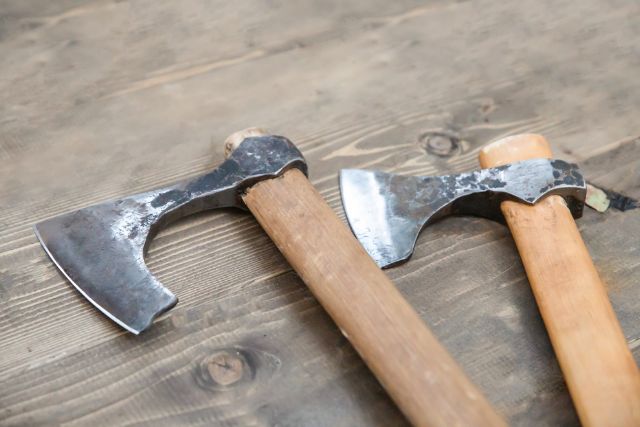
Iron and Steel
The blades of Viking axes were typically made from iron or steel. Iron was more common in the earlier part of the Viking Age, while steel became more prevalent as metalworking techniques advanced.
Steel blades were stronger, more durable, and held a sharper edge, making them highly sought after by warriors and craftsmen alike.
Wooden Handles
Viking axe handles were primarily made from wood, with ash, oak, and hickory being popular choices due to their strength and resilience. Handles were often crafted to fit the individual user’s hand and grip, ensuring a comfortable and secure hold during use.
Decoration and Ornamentation
Many Viking axes featured intricate decorations and ornamentation, including intricate carvings, inlays, and metalwork. These designs often depicted scenes from Norse mythology, stylized animals, or geometric patterns, and served as a testament to the skill and artistry of the craftsmen who created them.
Fighting Techniques
While Viking axes were versatile tools, they were also formidable weapons in the hands of skilled warriors. In this section, we will explore some of the fighting techniques employed by the Vikings when wielding their iconic axes in battle.
Gripping and Handling
The proper grip and handling of a Viking axe were crucial to its effectiveness in combat. Warriors held their axes with a firm yet relaxed grip, allowing for fluid movements and quick adjustments as needed.
The length of the handle and the weight distribution of the axe also played a significant role in determining the ideal grip and handling techniques for each type of axe.
Offensive Techniques
When using an axe in combat, Viking warriors employed a variety of offensive techniques designed to maximize the weapon’s cutting, chopping, and hooking capabilities.
Chopping and Slashing
Chopping and slashing attacks were the most basic and common offensive techniques used with Viking axes. These powerful strikes aimed to deliver devastating blows to an opponent’s limbs or body, often causing significant damage or incapacitating them with a single well-placed strike.
Thrusting and Hooking
Some Viking axes, particularly those with bearded blades or specialized designs, were well-suited for thrusting and hooking attacks.
These techniques targeted gaps in an opponent’s armor or aimed to hook their limbs, weapons, or shields, creating openings for follow-up attacks or disarming them altogether.
Combination Attacks
Experienced Viking warriors often employed combination attacks, seamlessly transitioning between different offensive techniques to create unpredictable and devastating attack patterns.
This mastery of the axe allowed them to adapt to various combat situations and opponents, making them formidable adversaries on the battlefield.
Defensive Techniques
In addition to their offensive capabilities, Viking axes also served as effective defensive tools when wielded by skilled fighters.
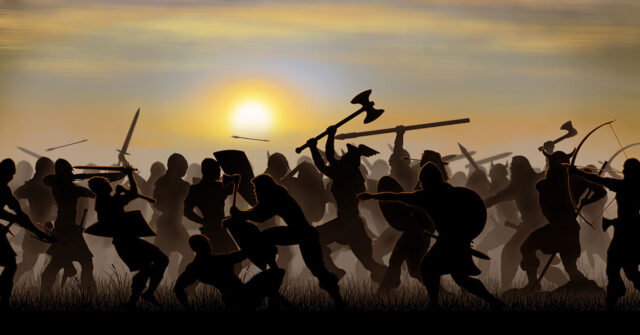
Blocking and Parrying
Blocking and parrying were essential defensive techniques used by Viking warriors to protect themselves from incoming attacks.
By positioning their axes to intercept or deflect an opponent’s strike, they could minimize or avoid damage while creating opportunities for counterattacks.
Disarming Opponents
Using the unique design features of their axes, skilled Viking warriors could disarm their opponents by hooking or catching an opponent’s weapon or shield. This tactic left their adversaries vulnerable and exposed, allowing for swift and decisive counterattacks.
Counterattacks
After successfully defending against an attack, Viking fighters were quick to seize the opportunity for a counterattack. Utilizing their axes’ cutting, chopping, or hooking capabilities, they would strike back at their opponents, capitalizing on the openings created by their defensive maneuvers.
Axes in Viking Warfare
Throughout the Viking Age, axes played a significant role in warfare, both on land and at sea. In this section, we will discuss the battlefield roles of Viking axes and their use in naval combat.
Battlefield Roles
Viking axes were employed in various roles on the battlefield, depending on their type and the tactics used by the warriors wielding them.
Long axes were often used by elite warriors on the front lines, delivering powerful strikes that could break through enemy defenses.
Short axes were more versatile and served as effective close-quarters weapons or secondary arms for warriors who primarily fought with other weapons such as swords or spears.
Axes in Naval Combat
During naval raids and battles, Viking axes were particularly effective due to their versatility and compact size. Warriors used axes to board enemy ships, cut through ropes and rigging, and engage in close-quarters combat with opposing sailors.
The unique design features of certain axes, such as bearded blades or hooking elements, made them especially useful in the chaotic and confined spaces of naval engagements.

Axes in Viking Society and Culture
The importance of axes extended beyond their practical uses in Viking society and culture, as they held deep symbolic and mythological significance.
In this section, we will explore the role of axes in Norse mythology, their function in daily life, and the archaeological discoveries that have shed light on their importance in Viking culture.
Symbolism and Mythology
Axes were deeply ingrained in Norse mythology, with several gods and legendary heroes wielding axes in their exploits. Perhaps the most famous example is the god Thor, who wielded the mighty Mjölnir, a magical hammer often depicted with axe-like qualities.
Axes also served as symbols of power, authority, and strength in Viking society, and their intricate designs often conveyed the social standing or accomplishments of their bearers.
Function in Daily Life
Apart from their use in warfare, Viking axes served a variety of functions in daily life. They were used for woodworking, farming, and shipbuilding, making them indispensable tools for the Norse people.
The versatility and practicality of the axe made it a common possession among both warriors and the common folk, ensuring its prominence in Viking culture.
Artifacts and Archaeological Discoveries
Over the years, numerous archaeological discoveries have provided valuable insights into the role of axes in Viking society. Well-preserved axes, often featuring intricate decorations and ornamentation, have been unearthed from burial sites and settlements across Scandinavia and other regions inhabited by the Vikings.
These artifacts serve as a testament to the craftsmanship, artistry, and importance of the axe in Viking culture.
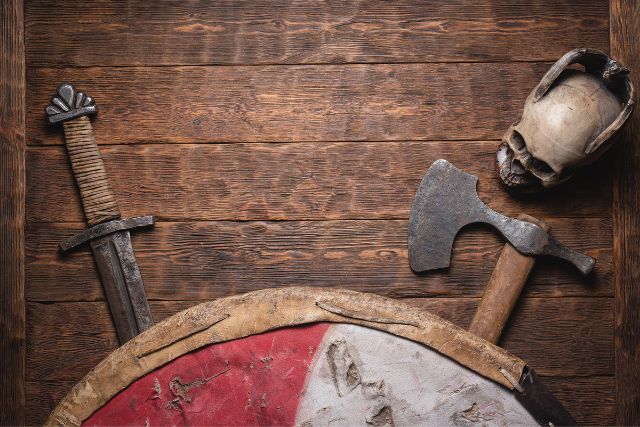
Conclusion: The Viking Axe Legacy
The Viking axe remains one of the most iconic symbols of the Viking Age, representing the strength, resilience, and ingenuity of the Norse people.
From their practical uses as tools and weapons to their symbolic significance in mythology and society, Viking axes have left an indelible mark on history.
The legacy of the Viking axe lives on not only through the artifacts and archaeological discoveries that continue to be unearthed but also through the enduring fascination and admiration for the skill and artistry that went into crafting these formidable weapons.
As we continue to learn more about the Vikings and their way of life, the axe will undoubtedly remain at the forefront of our understanding of this remarkable culture and its lasting impact on the world.









